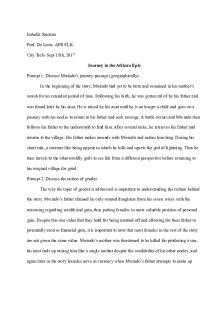Musc 19 short written assignment instrument use in african music PDF

| Title | Musc 19 short written assignment instrument use in african music |
|---|---|
| Course | Music of Multicultural America |
| Institution | FootHill College |
| Pages | 1 |
| File Size | 71.6 KB |
| File Type | |
| Total Downloads | 50 |
| Total Views | 129 |
Summary
evaluation of instrument use in african music...
Description
Short Written Assignment: Instrument Use in African Music Based upon the reading for this module and the below video discuss the use and types of instruments in African Music. Your discussion must include all instrument classifications from the reading and one specific example/citation from the streaming video. This assignment should be a minimum of 250 words in length and your thoughts and opinions. There are many instruments that are used in African Music. These instruments include a variety of drums which include tama talking drums, bougarabou and djembe in West Africa, water drums in Central and West Africa, and different types of ngoma drums in Central and Southern Africa. Besides the drums there are percussion instruments that are divided into two categories: instruments with rhythmic functions and instruments with melodic functions. Examples of instruments with rhythmic functions include large gongs, twin gongs, slit gongs, and ritual gongs; rattles and foot rattle; woodblocks, bells, double bell, shakers, such as the kosika, rainsticks, and woodsticks. Instruments with melodic functions include string instruments (musical bows, different types of harps and harp-like instruments like the Kora as well as fiddles), different types of xylophones and lamellophones, and different types of flutes and trumpets. These instruments are categorized into more specific classification groups: chordophones, idiophones, aerophones and membranophones, following the Hornbostel-Sachs system of classification. “Membranophones are instruments that produce sound by a vibrating membrane” (page 4). Drums are used as melodic and rhythmic instruments which come in different shapes and sizes. These drums are beaten with hands while others are beaten with a stick or rubbed. “Chordophones are instruments that produce sounds with vibrating strings, sometimes plucked, sometimes struck, sometimes with a bow” (page 5). The musical bow is one of the most simplest of these instruments which include the earth bow, the mouth blow, and the resonator bow. “Idiophones are instruments that produce sound by vibrating themselves” (page 6). These instruments include the xylophone, shaken, struck and scraped percussion instruments. They are both melodic and rhythm instruments and was the most abundant type of instrument found in Africa. “Aerophones, which produce sound by vibrating columns of air” (page 7). African aerophones divide into three categories: flutes, reed pipes, and trumpets and horns. In the video at 9:35, two instruments are introduced. The first instrument is called a Kora and it has 21 strings. It is made of wood and calibus, which is grown from the ground in Africa. There are three different sizes: small, medium, and large. It is used to recount the history of people. The second instrument is called the balaphone, which is also known as the African xylophone. In my opinion, African music is very nice and pleasing to the ear. It is easy to listen to and enjoy. Works Cited Jallow, Baba. “Traditional African Music at Creighton University.” YouTube , uploaded by Creighton University, 22 Feb. 2012, https://www.youtube.com/watch?time_continue=13&v=Kaoay8wDlDM....
Similar Free PDFs

African music quiz 1 notes
- 16 Pages

Written assignment
- 4 Pages

Written Assignment
- 4 Pages

Written Assignment
- 2 Pages

Journey in the African Epic
- 3 Pages

Music As Poetry Assignment
- 3 Pages
Popular Institutions
- Tinajero National High School - Annex
- Politeknik Caltex Riau
- Yokohama City University
- SGT University
- University of Al-Qadisiyah
- Divine Word College of Vigan
- Techniek College Rotterdam
- Universidade de Santiago
- Universiti Teknologi MARA Cawangan Johor Kampus Pasir Gudang
- Poltekkes Kemenkes Yogyakarta
- Baguio City National High School
- Colegio san marcos
- preparatoria uno
- Centro de Bachillerato Tecnológico Industrial y de Servicios No. 107
- Dalian Maritime University
- Quang Trung Secondary School
- Colegio Tecnológico en Informática
- Corporación Regional de Educación Superior
- Grupo CEDVA
- Dar Al Uloom University
- Centro de Estudios Preuniversitarios de la Universidad Nacional de Ingeniería
- 上智大学
- Aakash International School, Nuna Majara
- San Felipe Neri Catholic School
- Kang Chiao International School - New Taipei City
- Misamis Occidental National High School
- Institución Educativa Escuela Normal Juan Ladrilleros
- Kolehiyo ng Pantukan
- Batanes State College
- Instituto Continental
- Sekolah Menengah Kejuruan Kesehatan Kaltara (Tarakan)
- Colegio de La Inmaculada Concepcion - Cebu









